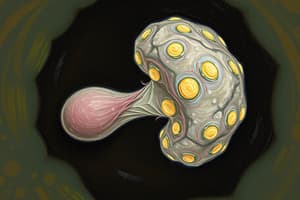Podcast
Questions and Answers
What volume of filtrate is used in the nitrogen detection test?
What volume of filtrate is used in the nitrogen detection test?
- 1 ml
- 4 ml
- 2 ml
- 3 ml (correct)
How many drops of ferrous sulfate solution are added during the nitrogen detection test?
How many drops of ferrous sulfate solution are added during the nitrogen detection test?
- 5 drops
- 3 drops
- 2 drops
- 4 drops (correct)
To make the solution basic, what percentage of NaOH solution is used?
To make the solution basic, what percentage of NaOH solution is used?
- 10% (correct)
- 20%
- 15%
- 5%
For how long should the solution be heated to boil during the nitrogen detection test?
For how long should the solution be heated to boil during the nitrogen detection test?
What indicates a positive test for nitrogen?
What indicates a positive test for nitrogen?
What is the role of acetic acid in the detection of sulfur?
What is the role of acetic acid in the detection of sulfur?
Which compound forms a black precipitate indicating the presence of sulfur?
Which compound forms a black precipitate indicating the presence of sulfur?
If lead acetate is omitted from the experiment, what would be the observed result?
If lead acetate is omitted from the experiment, what would be the observed result?
Which product is NOT formed in the reaction involving sodium sulfide and lead acetate?
Which product is NOT formed in the reaction involving sodium sulfide and lead acetate?
What is the chemical formula for lead sulfide?
What is the chemical formula for lead sulfide?
In the preparation of sodium ferrocyanide, what role does NaOH play in the reaction?
In the preparation of sodium ferrocyanide, what role does NaOH play in the reaction?
Which compound is formed as an intermediate before sodium ferrocyanide during the preparation steps?
Which compound is formed as an intermediate before sodium ferrocyanide during the preparation steps?
What is the overall charge of the ferric ferrocyanide complex Fe4[Fe(CN)6]3?
What is the overall charge of the ferric ferrocyanide complex Fe4[Fe(CN)6]3?
Which of the following statements is incorrect regarding the structure of sodium ferrocyanide?
Which of the following statements is incorrect regarding the structure of sodium ferrocyanide?
During the preparation of ferric ferrocyanide, what is the by-product formed along with ferric ferrocyanide?
During the preparation of ferric ferrocyanide, what is the by-product formed along with ferric ferrocyanide?
What is the primary purpose of adding alcohol to the test tube containing excess unreacted sodium before breaking it with heating?
What is the primary purpose of adding alcohol to the test tube containing excess unreacted sodium before breaking it with heating?
Why should the test tube be cautiously dropped into a beaker containing 20ml of D.W.?
Why should the test tube be cautiously dropped into a beaker containing 20ml of D.W.?
What is the expected appearance of the filtrate after the solution is heated to boiling and filtered?
What is the expected appearance of the filtrate after the solution is heated to boiling and filtered?
Which chemical reaction correctly describes the formation of sodium alkoxide in the experiment?
Which chemical reaction correctly describes the formation of sodium alkoxide in the experiment?
What should be done if the test tube does not break down after being dropped into the solution?
What should be done if the test tube does not break down after being dropped into the solution?
Flashcards are hidden until you start studying
Study Notes
Steps for the Experiment
- Cautiously drop the hot test tube into a beaker containing 20ml of distilled water to break it down.
- Use a glass rod if the tube doesn't break down.
- Heat the resulting solution to boiling and filter it.
- The filtrate should be colorless and is used for specific tests.
Removing Excess Sodium
- Add a small quantity of alcohol to the test tube before breaking it with heating to react with excess sodium, producing sodium alkoxide.
- The chemical equation for this reaction is 2Na + 2CH₃CH₂OH → 2NaOCH₂CH₃ + H₂.
Detection of Nitrogen
- Add 4 drops (0.2 gm) of ferrous sulfate solution to 3 ml of the filtrate.
- Make the solution basic by adding enough NaOH solution (10%).
- Heat the solution for 30 seconds and then make it acidic by adding drops of dilute H₂SO₄.
- A Prussian blue precipitate indicates a positive test for nitrogen.
Preparation of Ferrocyanides
- Sodium cyanide (NaCN) is prepared by fusion of sodium, carbon, and nitrogen from an organic compound.
- NaCN reacts with ferrous sulfate to form ferricyanide and sodium sulfate in the presence of basic NaOH.
- Ferricyanide reacts with sodium cyanide to form sodium ferrocyanide.
- Sodium ferrocyanide reacts with ferric sulfate to form ferric ferrocyanide, which has a blue color and is formed during boiling.
Chemical Structure
- The structure of ferric ferrocyanide is a square planar complex with a central iron atom bonded to four cyanide ions.
- Each cyanide ion is bonded to the nitrogen atom of a neighboring cyanide ion.
- The overall charge of the complex is -4, which is balanced by four sodium ions.
Chemical Formula
- The chemical formula for ferric ferrocyanide is [Fe(CN)₆]³⁻.
- The chemical formula for sodium ferrocyanide is [Fe(CN)₆]⁴⁻.
Detection of Sulfur
- Acidify 2 ml of the filtrate with dilute acetic acid.
- Add 5 drops of lead acetate solution to the acidified filtrate.
- A black precipitate of lead sulfide indicates the presence of sulfur.
- The chemical equation for this reaction is Na₂S + (CH₃COO)₂Pb → PbS + 2CH₃COONa.
Studying That Suits You
Use AI to generate personalized quizzes and flashcards to suit your learning preferences.




